‘Justice not charity’ - the blind marchers who made history
- Published

A century ago blind and partially sighted people marched on London to lobby the government to improve their living and working conditions. The 1920 Blind March has become a milestone in the history of the disability rights movement. But as recreating a large gathering is not possible in current circumstances, blind people are using their daily personal exercise to mark the anniversary.
Sixteen years before the historic Jarrow Crusade, a less well-known but perhaps even more remarkable trade union march arrived in London to demand action to end poverty.
Carrying banners with slogans such as "Social justice not charity", the protesters had travelled hundreds of miles to demand state aid, for those who like themselves were blind or visually impaired.
Over the previous three weeks the 250 marchers had promoted their cause to the wider public at large meetings in towns and cities along the way.
They sought government intervention to ensure that blind people were not condemned to poverty because of their impairment.
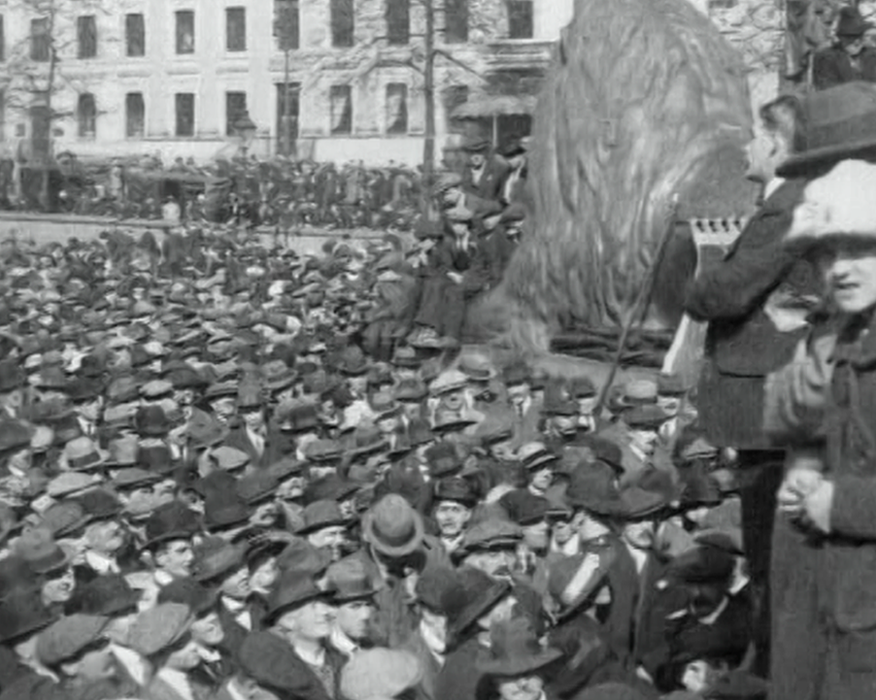
Crowds flocked to hear the marchers speak in Trafalgar Square
On their arrival in London on 25 April 1920, they were greeted at a rally in Trafalgar Square attended by 10,000 people.
Five days later a delegation was invited to Downing Street to put their case in person to the Prime Minister David Lloyd George.
While the march did not achieve all its aims, it increased pressure on the Liberal-Conservative coalition government to get the much-delayed Blind Persons Act on to the statute book.
This landmark legislation passed later the same year, placed a duty on local authorities to "promote the welfare of blind persons".
Allow X content?
This article contains content provided by X. We ask for your permission before anything is loaded, as they may be using cookies and other technologies. You may want to read X’s cookie policy, external and privacy policy, external before accepting. To view this content choose ‘accept and continue’.
A century on the Royal National Institute of Blind People (RNIB), is seeking to commemorate the anniversary of the march, and is urging blind people to mark the occasion by articulating what they believe still needs to be done to achieve equality.
The march was organised by the National League of the Blind (NLB), a trade union founded in 1899 by blind and partially-sighted workers to represent their own interests.
The RNIB's Director of Development Keith Valentine says: "The march is symbolic of what's possible if you take the action yourself. It's the sense of 'this is not fair, and I will not be pushed around, and I am a citizen of this country.'"
Harsh charity
Historian Francis Salt says that in the years prior to the march the NLB had unsuccessfully campaigned for action to improve the lives of blind people, many of whom depended on employment in workshops, run by charities where conditions were often poor and wages low.
"The match was a culmination of their frustration that nobody seemed to be taking any notice," says Salt, who is himself blind.
The charities exercised significant control over their workforce. In some cases, employees had to seek permission from their bosses to marry.
Francis Salt recalls how his own blind grandfather was employed as a brush maker at a workshop in Manchester.
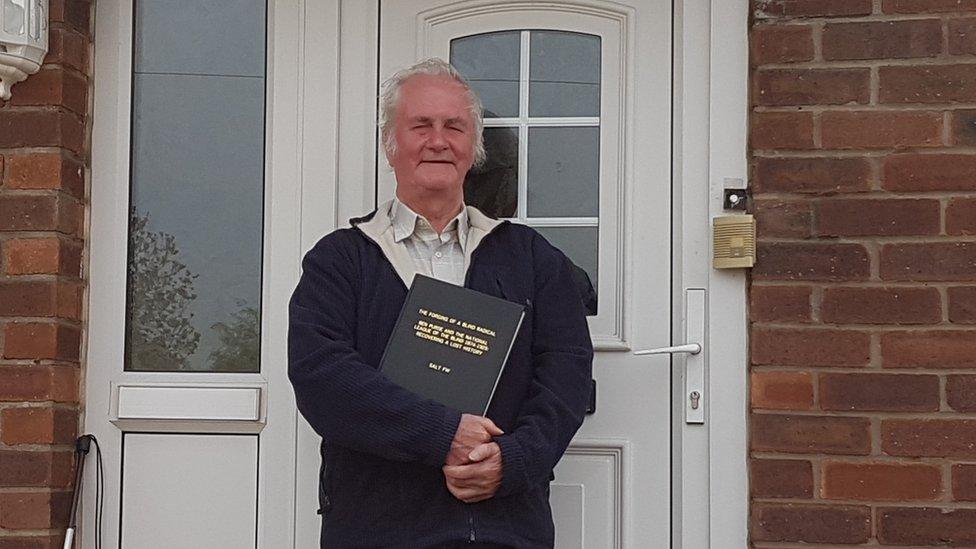
Francis Salt says the marchers were tired of being ignored
"My mother told me that my granddad used to come home with tar all over his fingers," he says. "And if you consider these men that we're talking about in 1920, their main way of reading was by Braille, then the last thing they wanted was their fingers being burned every day."
The low wages paid by the workshops left many struggling to get by.
One of the leading figures behind the march, NLB official David Lawley, a former miner who was blinded by a dynamite explosion in 1913, wrote: "Of 35,000 blind people in the country 20,000 were existing below the poverty line. There were 850 beggars on the streets of London and 200 at Manchester.
"The blind have lost faith in charitable institutions being able to promote their welfare, and what they wanted was state aid to make the unfortunate class, to which they belonged, as self supporting as possible."
By comparison, the NHS says, external that today there are almost two million people living with sight loss. Of these, around 360,000 are registered as blind or partially sighted.
'The bigger the better'
Efforts to introduce legislation to improve life for the blind people had stalled, even after some soldiers lost their sight in World War One.
The league resolved to do something that would make an impact.
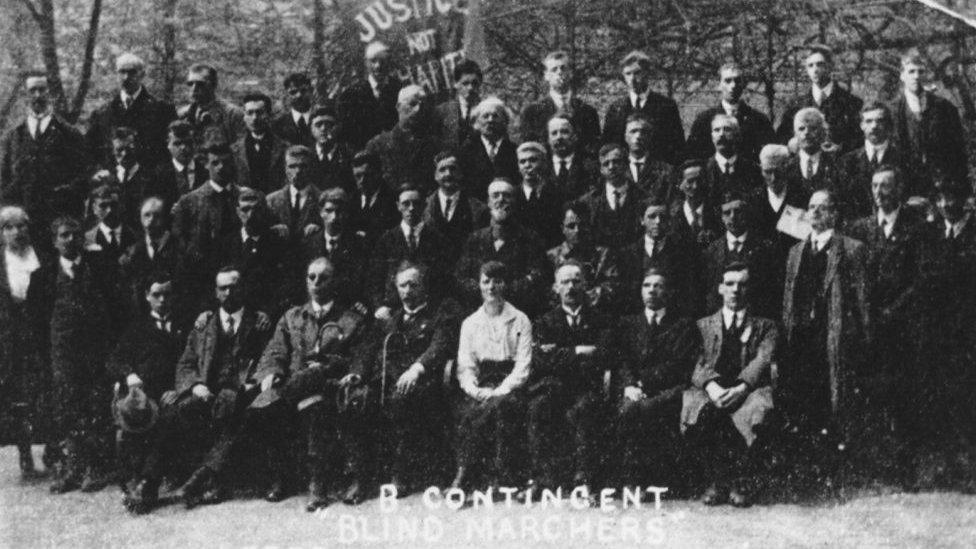
The league was affiliated with the Labour Party and TUC
"Let us go to London, and the bigger we do things the better," the movement's journal, the Blind Advocate proclaimed in February 1920, as plans for the march were formed.
On Easter Monday marchers from all over the UK set off in three groups from Manchester, Leeds and Newport. Although the workshops employed both sexes, it was decided that only men should march as conditions were expected to be basic.
A policy decision was also taken that blind soldiers should not go. The union did not want to play on patriotic sentiment in its efforts to raise public awareness of the plight of the blind Francis Salt says.
"They didn't want sympathy. They wanted understanding," he says.
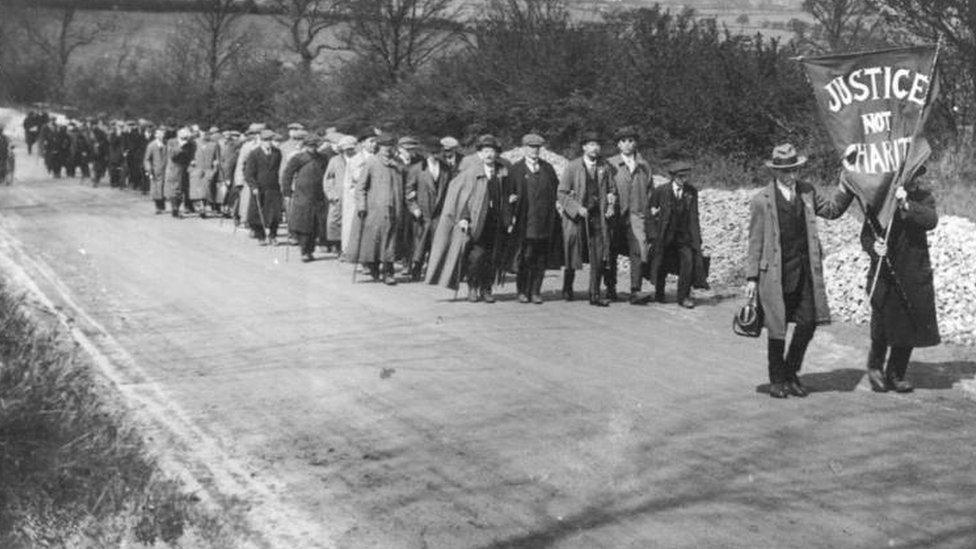
The marchers covered hundreds of miles on foot and the occasional lift
One challenge that had to be overcome was finding a way for columns of blind men to safely travel through the country on foot, in an era before the use of guide dogs.
Salt says: "Some had a rope running through the centre with two men linking arms on either side and a sighted guide in front, whilst another group preferred to link arms four abreast following the guides.
"Whistles and shouted commands were used to direct and keep the marchers safe when mixing with other road transport and the local police escorted the march from town boundary to town boundary."
It must have been an extraordinary logistical feat to pull off. And the sight of the marchers was, according to contemporary accounts, enough to move some women at the roadside to tears, says Francis Salt.
But he notes that the march was also not without its humorous moments: "They weren't opposed to cadging a lift. From Stafford to Stone they got the train because it was pouring down. In another place the city fathers sent a fleet of buses out for them, so they could get to the meeting on time."
At night, the marchers often stayed at the homes of supporters, and on occasion some were put up in police cells.
Downing Street meeting
Eventually the three groups joined up at Leicester for the final stages.
On arrival in the capital, the marchers spent several days waiting for their "interview" with the prime minister. During that time some of the men were invited to tea at the House of Commons by Lady Astor, only the second woman to be elected an MP.
The meeting with Lloyd George, when it came, proved "disappointing" says Francis Salt.
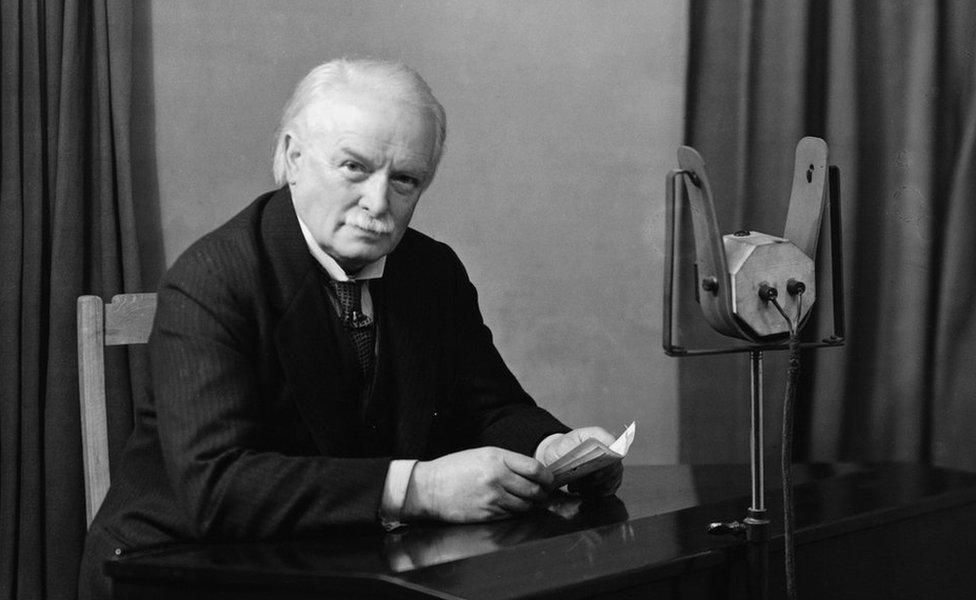
Lloyd George promised to pay the marchers' fares home but little else
The NLB's leadership pressed for "a compensation for blindness grant" to ensure that the blind did not have to live on less than the sighted. They also wanted the state to guarantee better education and employment opportunities.
Francis Salt says they also feared that the proposed Blind Persons bill, as drafted, would allow local authorities to sub-contract the duties the legislation placed on them to the very charities the NLB opposed.
Lloyd George responded that he would look at their demands sympathetically. But he stressed that the war had increased the national debt and "our taxes are about the heaviest in the world".
The only firm commitments given were that the government would provide rail tickets, so the marchers did not have to walk home, and a promise that none of the men would face reprisals from their employers for going on the march.
After leaving the meeting, the NLB passed a resolution recording their dissatisfaction with Lloyd George.
"Such phrases as he employed do not lead us to anticipate that drastic changes are about to be made in the condition of the blind and such a circumstance is in itself wholly unsatisfactory," it noted.
Despite this disappointment, the bill that the march helped to bring about was the world's first disability-specific legislation. Among the advances it contained was a lowering of the age at which the blind people received their pension from 70 to 50.
Socially-distanced solidarity
A century on the march is regarded as a disability rights milestone.
To mark the anniversary the RNIB is urging blind and partially sighted people to use their daily exercise to take their own symbolic steps for equality. Some campaigners have responded by posting videos with the hashtag #BlindMarch reflecting on the march and life today.
Several of their contributions have been collected by the RNIB in a video, external which mixes archive footage of the 1920 marchers with their counterparts of today.
Allow X content?
This article contains content provided by X. We ask for your permission before anything is loaded, as they may be using cookies and other technologies. You may want to read X’s cookie policy, external and privacy policy, external before accepting. To view this content choose ‘accept and continue’.
Among those featured is Holly Tuke, author of the blog Life of a Blind Girl, who said: "There have been many positive changes that have had a significant impact on the lives of blind and partially sighted people over the last 100 years, however we still have a long way to go to achieve equality.
"Over the next 100 years I'd like people to see our ability, not just our disability."
For historian Francis Salt, the lockdown has removed a more literal obstacle that has prevented him living as he would like.
"The biggest hinderance to blind people like myself - who is very independent and got a guide dog - is people parking on the pavement. That's the biggest threat to my wellbeing that I meet on a daily basis. And believe it or not in the last five weeks I've not had one incident, because they have all stayed at home!"

For more Disability News, follow on Twitter, external and Facebook, external, and subscribe to the podcast.
